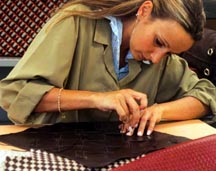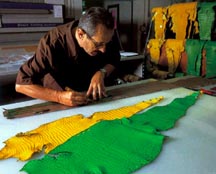In chapter four of The Substance of Style I discuss how unusual aesthetics often start as ideological or religious statements, only to have their meanings diluted over time, as more and more people adopt them, at first because they embrace some of the original meaning and then increasingly simply because they like the style. The same pattern occurs with such diverse styles as neo-Gothic architecture in the 19th century and dreadlocks in the 20th century.
In an article on the new book Queens: Portraits of Black Women and Their Fabulous Hair, the NYT's Guy Trebay delves a bit into the complex relationship between pleasure and meaning in the styling of black women's hair.
"Black people perhaps have always pushed the boundaries of creativity in this country," explained [Queens author] Mr. [George] Alexander, whose book is also the subject of an exhibition at the Southeastern Center for Contemporary Art in Winston-Salem, N.C. "During the slave era there were obvious limits in terms of what you could do, since you were considered property. Basically, ever since, there has been this expanding desire to express oneself." That expression now takes the form of hairstyles that may involve the chemical processes that continue to stoke the multibillion-dollar, so-called ethnic personal-care market, but that equally results in Macy Gray Afros or the microbraids popularized by African immigrants, or else corn rows or Bantu knots or Bolga braids or the Barbie-style hair extension favored by Naomi Campbell and Beyoncé Knowles.
Most surprising perhaps, among the styles now popular among African-American women is dreadlocks (now called locks), an ancient coiffure often exclusively associated with the Rastafarians and now an ordinary hair-care option at many black hair salons.
"Fifteen years ago locks were still a heavily politicized thing," explained Shannon Ayers, the proprietor of the Harlem salon and day spa Turning Heads, who appears in "Queens" with her locked hair plaited into braids as thick as hawsers.
A decade ago, when Ms. Ayers decided to abandon her corporate job in publishing, she stopped processing her hair and let it lock naturally. Her early experiments involved nothing more radical than prim little twists. Even at that, "my family thought I had lost my mind," she said. "And if I met a Mr. Banker or Lawyer, the reaction was, 'I can't be bringing somebody with these little Buckwheat things in her head to my corporate functions.' "
Now about half the clients at Ms. Ayers's salon come to have their hair styled in the locks, twists and coils worn by women as disparate as Ms. Morrison and Lauryn Hill.
"It's not radical anymore," said Cherare Robertson, a police officer in Washington, whose rust-tinged and restyled locks were set to dry one afternoon last week beneath a cap dryer that anomalously brought the Donna Reed 1950's to mind. "A couple years ago I just stopped worrying about satisfying society and started to enjoy my own beauty," she said.
Queens, which I haven't seen, includes glamorous black-and-white portraits by Michael Cunningham, whose earlier book Crowns: Portraits of Black Women in Church Hats is a favorite of mine.
Posted by Virginia Postrel on November 24, 2005 • Comments
A reader writes:
The part of Almost Girl's post that you left out in the middle of that paragraph actually interested me a great deal. You know, about arts patronage. The sort of socialite who's going to drop $20,000 for a handbag is, after all, exactly the sort who probably also sits on opera and orchestra boards and may have donated a wing to the art museum with her husband. That's not the same as shoving a briefcase full of cash at an individual starving artist, but buying artworks is; rich people do that, too.
Actually, I think that for those of us who are affluent but not super-loaded--a much larger segment of the population--Almost Girl's calculations are still somewhat off. I decided to splurge and spent $600 on two credit card wallets last week. (That's not a frequent event in my life, just so you know--though I did smirk and think, Take that, Anna Quindlen, as I handed over my credit card.) But I did so after I'd planned my holiday season budget, including what I was going to donate to charitable organizations. If I hadn't spent that $600 at Vuitton, it would have sat in my bank account. Of course, it would have been invested from there, anyway, but this way part of it goes directly to the wages of not only leatherworkers and vice presidents of marketing but also saleswomen, janitors, and security guards. I don't see why helping them make a living is wasteful.
Posted by Virginia Postrel on November 23, 2005 • Comments
Julie Frederickson, a.k.a. Almost Girl, has done a great job rounding up blog posts that provide a window into the attitudes of the young and fashionable. As someone who thinks Carrie Bradshaw had great attitude but hideous clothes (and don't get me started on the scary, misanthropic Jim Kuntsler), I feel a little out of place on her Black Friday blogroll. I'm more comfortable around computer geeks, not to mention economists, than fashionistas. But I do like beautiful, tactile clothes and the markets that provide them.
Those markets don't always behave the way fashionistas would like, leading to some contradictory blogging on Julie's part. In this post, she bemoans the latest trend in luxury markets, quoting a WWD article:
In a buoyant luxury market, ultraexpensive items--from $6,000 Azzedine Alaïa shearling jackets to $21,000 Bottega Veneta handbags--have become a surprise hit, selling briskly to a superrich clientele in search of the exceptional.
Julie has understandable sticker shock. What a waste of money! "I'll tell you what, you want to get something exceptional? Fund me for an entire year! I can easily live off of $21,000 (I live off of about $1,000 a month now and quite comfortably I might add, not including the cost of my college tuition). For the cost of one of your hand bags you could send me to New York City so that I could have the resources to pursue my dream in the glossies....So if anyone out there is reading this blog I would like a patron please! I promise to provide compelling articles, do valuable research, and add a needed dose of intellectualism to the fashion scene! Will you really miss the handbag?"
As an equally bourgeois person who considers my $400 purse (bought when I was 45 and had been self-supporting for more than two decades) a huge splurge, I sympathize. But this attitude directly contradicts an earlier posting on how the trendy but cheaply constructed "fast fashion" (analogous to fast food) at stores like H&M has eroded the public's appreciation of craftsmanship and fine design. Julie and other fashion bloggers also worry that big chains, with their mass merchandising, make it hard for young designers to find a market.
The "fast fashion" post mixes a lot of different issues, but the economic bottom line is that people should buy more expensive clothes, at more expensive stores, and keep them longer. "Let's appreciate everything that goes into our clothing, have less of it but make it better," she writes.
Here we have a classically bourgeois attitude, with an elitist twist. Cheap is bad, and so is expensive. The right price is the one I'm willing to pay. The right priorities are mine.


But those Bottega Veneta bags are expensive for a reason. They not only use luxurious, expensive materials, but require meticulous, time-consuming craftsmanship. Only a few people in Italy have the necessary skills. And since the "production runs" are quite small, distribution and logistic costs are quite high per bag. I'm not saying that everyone should lust after a $21,000 purse (my car didn't cost that much, and I bought it new), only that rare design and craftsmanship have a cost. You can't have Bottega Veneta quality at H&M prices. The ultra-high end market is preserving artisanal skills.
 And luxury companies know that in a world of fast fashion, they need to sell the intrinsic qualities of their merchandise. "We are back to luxury as an indulgence, not a show," said Bottega Veneta CEO Patrizio di Marco at the World Luxury Congress, a conference last month in Paris. (I was one of the speakers, the only one who talked not about luxury per se but about the increasingly aesthetic economy in which luxury goods compete.)
And luxury companies know that in a world of fast fashion, they need to sell the intrinsic qualities of their merchandise. "We are back to luxury as an indulgence, not a show," said Bottega Veneta CEO Patrizio di Marco at the World Luxury Congress, a conference last month in Paris. (I was one of the speakers, the only one who talked not about luxury per se but about the increasingly aesthetic economy in which luxury goods compete.)
The great thing about fashion markets today is how diverse they are, even outside of major metro areas. Many different styles coexist and there isn't a simple, price-based status hierarchy. You can buy trendy but disposable clothes--"fast fashion"--or classic, enduring pieces. Basic jeans, sweaters, and T-shirts cost about the same, in nominal dollars, as they did when I was a teenager in the late 1970s, and their materials and construction are generally much better. Those cheap clothes are also helping a billion Chinese climb out of abject poverty.
The bad thing about fashion markets today is how many empire-waist tops and dresses they sell. I don't care how cute, young, and skinny you are. Those things make you look pregnant.
Posted by Virginia Postrel on November 22, 2005 • Comments
Amazon has a horrible new feature--a customer-written "ProductWiki" on each book's page. Since the wiki is not supposed to include reviews, it's not clear what value customers are going to add to help people decide whether to buy a book (that's the point, right?) Worse, the now-vacant wikis produce browser error messages when I load an Amazon page. It all seems like trendiness, not customer service.
Posted by Virginia Postrel on November 22, 2005 • Comments
Phil Bowermaster at the Speculist is looking for examples of do-it-yourself innovations that represent "an unwillingness on [the inventors'] part to wait for big corporate R&D departments to produce what they want." This is an increasingly important--and increasingly recognized--phenomenon, on which I've blogged in the past.
Posted by Virginia Postrel on November 22, 2005 • Comments
Black Friday is not in fact the year's biggest shopping day, but it does kick off quite a shopping season. And now, reports the WSJ's Mylene Mangalindan, Black Friday has been joined by Black Monday: "On that day, consumers head back to work -- and their computers -- ready to shop after the long holiday weekend."
In a recent article in Economics Letters, University of Missouri economist Emek Basker examines whether sales increase if there are more days between Thanksgiving and Christmas. Basker finds "a statistically significant increase in per-capita retail sales in November and December (combined) of approximately $6.50 per additional day over the relevant range." That doesn't sound like much, but it adds up: "The implied difference between the shortest and longest shopping seasons is $39 in spending per capita, or 20% of holiday spending in an average year."
Posted by Virginia Postrel on November 22, 2005 • Comments
Congratulations to my good friend Lynn Scarlett, who was confirmed on Friday as deputy secretary of the Interior. Lynn had been the department's assistant secretary for policy, management, and budget. She was was nominated as deputy secretary in February, but her confirmation was held up for months by a series of senators with unrelated grievances against the Interior Department.
Posted by Virginia Postrel on November 21, 2005 • Comments
Julie Frederickson of Almost Girl has organized a week of political fashion blogging, leading up to Black Friday:
Thus I am inviting you to participate in a fashion blogging event. Next Friday is Black Friday, the biggest shopping day in America. I am asking other fashion bloggers to join me in blogging about their own views on fashion, consumption, individuality, and the importance of fashion in our lives. I am encouraging any other fashion bloggers to join me in this endeavor, just make your own political fashion statements about your view on consumption and fashion and I will link up and we can hopefully dialogue about the importance of individuality in fashion! I would like this to grow organically so please email your fashion blogging friends to join the fun!
A slew of blogs are participating, and I will add my own thoughts over the next few days. For starters, I have to say that Julie's blog slogan, "Where Plato and Prada Meet," makes me feel really old. Back in the Dark Ages, when I was in school, girls who read philosophy did not follow fashion. (This essay suggests things may not have changed as much as I thought. For the record, it takes me 30 minutes to get ready in the morning, 45 minutes if I'm incredibly slow and do something complicated with my hair. But then I'm a nerd at heart.)
Posted by Virginia Postrel on November 19, 2005 • Comments
Greg Benford and Michael Rose have a cool new website featuring essays and promising a blog.
Authors in need of websites--or improved websites--should check out the site's designer, who specializes in authors at very affordable rates.
Posted by Virginia Postrel on November 19, 2005 • Comments
Megan McArdle has gift suggestions for the cooks in your life, with Amazon links.
The orange zester sounds like just the thing for my favorite new cake trick--chocolate orange. You take a regular chocolate cake mix, add zest from three oranges, and substitute orange juice for water. I use Duncan Hines devils food cake mix, and three oranges produce almost enough juice to replace the water the mix calls for. I usually make up the difference with Minute Maid, but you can just fill in with water if you don't have prepared juice handy. Or you can use four oranges. Yum.
UPDATE: On Thanksgiving, the orange-chocolate cake was a big hit with the extended Postrel clan. And I even got to give my sister-in-law's zester its first use ever.
Posted by Virginia Postrel on November 19, 2005 • Comments


 And luxury companies know that in a world of fast fashion, they need to sell the intrinsic qualities of their merchandise. "We are back to luxury as an indulgence, not a show," said Bottega Veneta CEO Patrizio di Marco at the
And luxury companies know that in a world of fast fashion, they need to sell the intrinsic qualities of their merchandise. "We are back to luxury as an indulgence, not a show," said Bottega Veneta CEO Patrizio di Marco at the